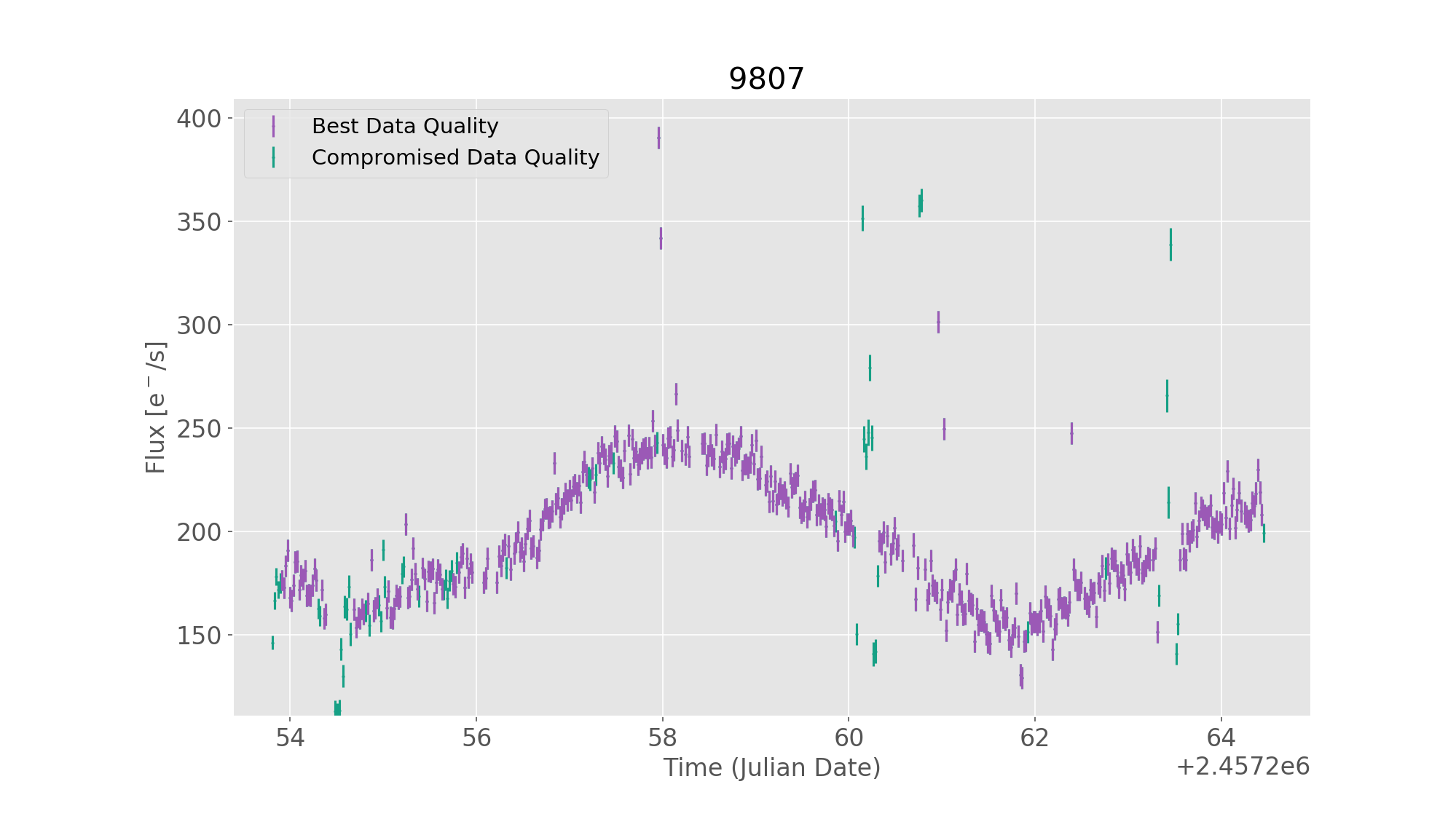9807
9807 (a.k.a. 9807, 1997 SJ4) is a moving object from K2 campaign 6. You can read more information about this object at the JPL Small-Body Database Browser here. Data was taken from 03 August 2015 to 12 September 2015.
9807 was proposed for by Ryan in GO6025. If you use this data, please cite their proposal. You can find the bibtex citation by clicking the button below.
@ARTICLE{asteriks,
author = {{Hedges}, C. and Co},
title = "{}",
journal = {},
archivePrefix = "arXiv",
eprint = {},
primaryClass = "",
keywords = {},
year = ,
month = ,
volume = ,
pages = {},
doi = {},
adsurl = {},
}@MISC{2014ktwo.propGO6025,
author = {{Ryan}, R. and {Woodward}, W.},
title = {Lightcurves of Trojan and Hilda asteroids: Insight into the formation of planetesimals},
abstract = {Studies of the small bodies of the solar system reveal important
clues about the condensation and formation of planetesimal bodi
es, and ultimately planets in planetary systems. Dynamics of sma
ll bodies have been utilized to model giant planet migration wit
hin our solar system [1-5], colors have been used to explore com
positional gradients within the protoplanetary disk [6-7], and s
tudies of the size-frequency distribution of main belt asteroids
may reveal compositional dependences on planetesimal strength w
hich may limit models of planetary growth from collisional aggre
gration of planetesimals. Studies of the optical lightcurves of
asteroids also yield important information on shape and potentia
l binarity of asteroidal bodies.Light curves of Hilda and Trojan
asteroids populations yield key information about the primordia
l shape and binary fraction of these small body populations. Mil
li-mag Kepler photometry will tightly constrain both of the latt
er characteristics. These two populations are in stable resonanc
es with Jupiter (Hildas in the 3:2 resonance at 4 AU, Trojans ar
e located at 5 AU in the L4 and L5 Lagrange points of the Sun-Ju
piter system) and collisional frequencies within these populatio
ns are the lowest within inner solar system small body populatio
ns [8-9]. Results from the WISE survey suggest that ~20% of Troj
an asteroids and ~40% of Hilda asteroids are either extremely el
ongated objects, or are binaries[10]. Kepler optical light curve
s are required to confirm these controversial findings. Ground b
ased optical surveys are not optimal for this type of photometri
c variability survey. Large amounts of observing time are requir
ed, and analysis of lightcurves obtained over a few nights is ha
mpered by aliasing induced by limited photometric sampling over
regularly spaced nightly intervals. Kepler however is ideal for
this type of photometric survey of asteroid variability due to t
he photometric stability of the observing platform and the corre
spondence between the Campaign 6 field and the L4 Trojan cloud.W
e have identified ~120 objects for study in the Hilda and Trojan
asteroid populations to be studied with Kepler in Campaigns 6 &
amp; 7 with magnitudes of m_V < 20. Due to the overlap betwe
en the Campaign 6 field and the L4 Trojan cloud, our request for
data represents 110 objects Campaign 6 and 10 objects in Campai
gn 7. These objects are not stationary within the Kepler fields,
rather they move across the field, resulting in a mean time in
the Kepler field of view on active silicon of 24 days for our ta
rgets. We will utilize data obtained with the 30 minute Kepler c
adence to determine rotational periods for our selected targets.
The ratio of lightcurve amplitudes will subsequently be utilize
d to determine body elongation and/or binarity to test the resul
ts reported by the WISE survey.}
howpublished = {K2 Proposal},
year = {2014},
month = {October},
url = {https://keplerscience.arc.nasa.gov/data/k2-programs/GO6025.txt},
notes = {K2 Proposal GO6025}
}
Acknowledgement:
This work uses...Download Light Curve
If only want the light curve of the object with the optimal aperture, download this product. This will give you one .fits file with several extensions. The first extension is the optimal apertures determined for this target. Further extensions contain a range of aperture sizes. You can read more in our readme.
Download Target Pixel File
Our code asteriks creates Moving Target Pixel Files, which are similar to Kepler/K2 TPFs, and contain stacks of images from the telescope. Moving TPFs track the motion of solar system objects, so that they are always centered in every image. Moving TPFs are background subtracted. The movie above shows a Moving TPF with background subtraction on the right.
Run our code
You can run our code asteriks to regenerate any of these light curves yourself, or generate light curves of other objects. You can read more about our code at our GitHub Page and you can read more about how the code works in our recent paper
